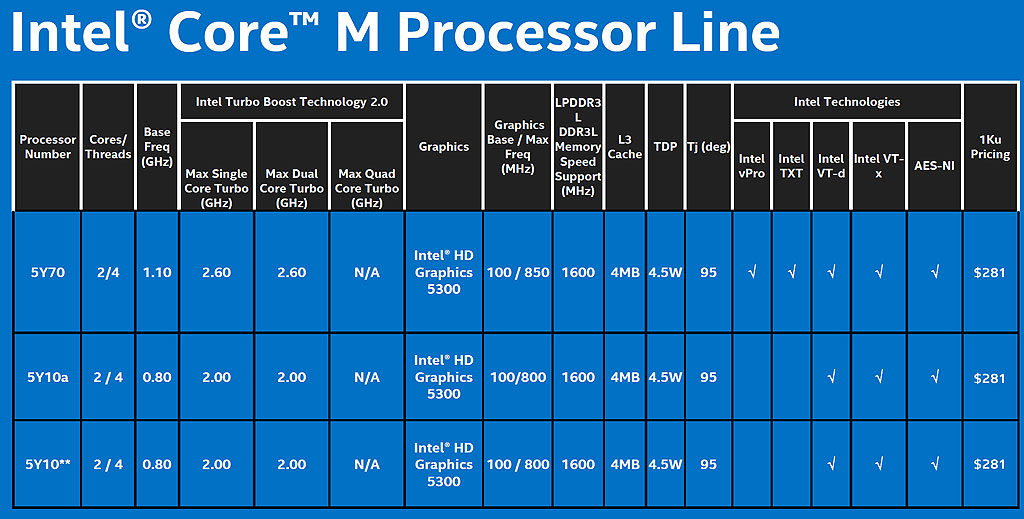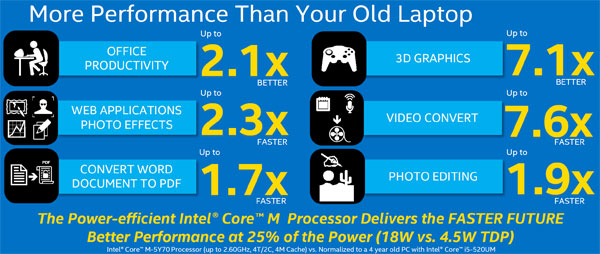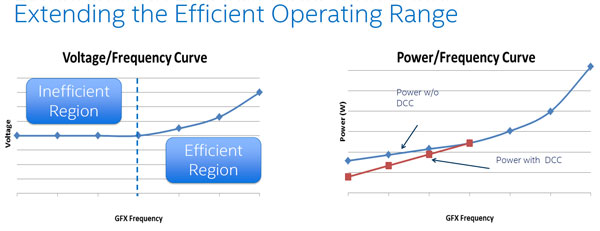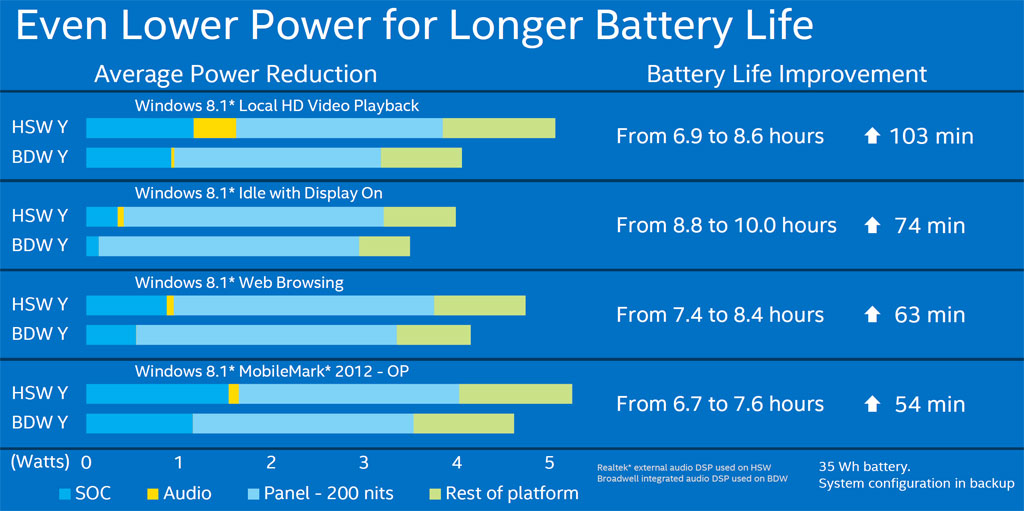Intel's Broadwell Core M Processor: New Details, SKUs and Specifics
Intel reveals more technical details about the Core M, and we get our first peek of Broadwell-Y processing and battery performance comparisons.
Processor manufacturer Intel has released some details on its 4.5-Watt Core M CPU lineup today, including specific model numbers and bulk pricing. We know you're itching for the technical details, so let's go straight to the specifications:
The 4.5 Watt TDP is definitely the defining factor of these low power models, enabling their use in completely fanless enclosures such as ultra-thin tablets, detachables and clamshells. All of these CPUs are equipped with two execution cores capable of processing four concurrent threads thanks to Intel's Hyperthreading technology, and every one of them features 4 MB of shared L3 cache.
We remind our readers that previous-generation Haswell-based mobile Core i7 CPUs can range from 4 to 8 MB of cache, with minimum TDPs of 11.5 Watts. All Broadwell-Y processors have Intel VT-d, VT-x and AES-NI instruction support, but only the top-of-the-line Core M-5Y70 features Intel vPro and TXT.
The miniscule power envelope limits these products to nominal clock rates between 800 and 1100 MHz, with boost rates from 2 to 2.6 GHz depending on the model. All 4.5 W Core Ms share a 1600 MHz LPDDR3L maximum memory clock, a 95-degree temperature limit before throttling becomes necessary, and graphics clock rates between 100 and 800 MHz.
While we don't have specific benchmark numbers to share yet, Intel provided some data for us to ponder (above). This slide compares the new Broadwell-Y Core M-5Y70 4.5 Watt processor against the 18 Watt Core i5-520UM, a previous-generation model based on the Nehalem-core.
Admittedly, that's a four-year-old target, but I've used laptops with this particular CPU, and it's a decent mobile workhorse. In general, it looks like we can expect roughly double the performance from the Core M in the majority of tasks, with over seven times the performance when it comes to graphics-oriented workloads. This isn't much of a surprise considering Intel's focus on IGP improvements over the past few generations of processors, but it does give us a frame of reference for the kind of responsiveness we should expect from a fanless detachable-tablet PC driven by Broadwell-Y.
Speaking of graphics, as you can see from the die shot, Intel has allocated plenty of space to IGP transistors on the Core M. The Broadwell-Y GPU is home to three graphics blocks with 8 AUs per block, for a maximum potential of 24 AUs. Of course, some of these could be disabled on different products depending on the target power characteristics and market position. For reference, Haswell-Y (the predecessor to Broadwell-Y) maxed out at 20 AUs, so it will be interesting to see how Core M performs against previous-generation parts with less GPU resources but higher TDPs. By the way, all Broadwell-based IGPs are DirectX 11.2, OpenGL 4.2, and OpenCL 2.0 compatible.
Get Tom's Hardware's best news and in-depth reviews, straight to your inbox.
This is a good time to touch on one of the Core M's most impressive innovations to preserve power: duty cycling control (DCC). For the first time in a PC graphics processor, GPU transistors can actually be shut off entirely for periods as long as seven out of eight clock cycles, which equates to as little as 12.5 percent of the nominal clock rate. This has the potential to preserve a lot of power and lower heat generation when the IGP is idle or processing a small workload. Of course, this feature offers no benefit under heavy workloads, but it should help save battery power during everyday tasks such as word processing or web surfing.
DCC is only one of Broadwell-Y's many battery-saving features, though. Intel's 14nm process node is not the least of them, and the redesigned PCH with improved audio DSP is another factor. We've talked about these in our Introduction to Intel's 14nm Node and the Broadwell Processor, and Intel has now provided some hard data to demonstrate the battery life improvements that Broadwell-Y brings to the table.
The following chart shows the real-world difference we can expect to see from a mobile device equipped with a 4.5 Watt Broadwell Core M-5Y10 vs the 11.5 Watt Haswell-Y Core i5-4302Y. You can see from the breakdown that the main power reductions are due to the new SOC and audio DSP. According to Intel's benchmarks, this translates from a one-to-two hour improvement in real-world tasks such as HD video playback and web browsing. We really do look forward to testing Broadwell-Y battery life in our labs.
I'd like to touch on the elephant in the room: why is Intel pushing Windows tablets when the world doesn't seem to be all that interested in them? It's no secret that for every 100 tablets sold on the market, fewer than five are powered by a Microsoft operating system -- and that includes Windows RT.
To Microsoft's credit, that number is slowly growing as market share erodes from Apple (and we should mention that Android is also growing stronger at Cupertino's expense). Clearly, fanless Broadwell-Y CPUs are a direct attack on the premium tablet market from a performance perspective, but with the 4.5 Watt Core M CPUs costing $281 each, in bulk lots of 1000, this product will not draw people from the colossal budget segment. Core M is intended to bring the convenience of a tablet/convertible to folks who would have otherwise purchased a laptop in the $1000 range.
In general, I'm loathe to share marketing-oriented slides that don't offer technical data, but coming from the perspective of a consumer who values mobility and has genuinely tried to perform serious productivity-oriented tasks on iOS and Android tablets, I have learned that -- for me -- Windows 8.1 x64 is the only viable option.
Microsoft's OS allows me to consume media just as well as an iPad or Nexus tablet while affording the utility of a reliable Microsoft Office environment, an accessible PC-based file system and the ability to access a massive library of x86 legacy software. That includes games, as we showcased in our article Is Your Windows 8 Tablet Fast Enough For PC Gaming? I know from dialogues and market share statistics that my point of view represents the minority, and I suspect that users tend to latch on to the tablet ecosystem with which they have their first experience.
Having said that, the prospect of a fanless tablet that can run Microsoft Windows at a decent clip really appeals to me, and I can envision the laptop market giving up more of its share to this type of device. Only time will tell of course, and I have to admit my bias as I probably represent the target market for a 4.5 Watt Core M processor.
In any case, we are told that Broadwell-Y Core M availability begins in OEM systems starting this October. As for Broadwell-U, the ultrabook version of this new Intel architecture, Intel says it will be in volume production before the end of this year and will arrive to market in early 2015. And of course we can't forget Broadwell-H, the socketed desktop version of this CPU featuring improved Iris Pro graphics. We can expect that product to arrive in 2015. Until then, check in with Tom's Hardware during IDF, as it's likely that Intel will release more details during its event.
Follow us @tomshardware, on Facebook and on Google+.
Don Woligroski was a former senior hardware editor for Tom's Hardware. He has covered a wide range of PC hardware topics, including CPUs, GPUs, system building, and emerging technologies.
-
hannibal These seems to be perfect for Surface mini type tablets! More powerful that cheap Atom tablets, but you can use these in smaller than normal size Surface tablets.Reply
8" Surface pro with one of these would be really nice tablet! -
dovah-chan I used to not think anything at all about power efficiency but after getting my laptop last year and flexing its battery, I've realized how much we need this. Really looking forward to seeing how far Intel can push their mobile lineup.Reply -
gnarr "I'd like to touch on the elephant in the room: why is Intel pushing Windows tablets when the world doesn't seem to be all that interested in them?"Reply
Because no android tablets or iPads use x86 CPU's... -
hst101rox I wonder if there will be room in the cheap laptop market for both 14nm Atom and Broadwell-Y. Atom will probably mostly be about tablets and phones but who knows.Reply
Very interested in the high end laptop Broadwell chips! What clockspeeds will we see, will we see a 6 core laptop chip? -
sonofliberty08 looks like Intel has learn a lot from the AMD APU, CPU power are no longer that important, GPU is the futureReply -
agentbb007 ReplyMy very first PC was a Pentium 3 and it also ran at 0.80GHz, which is basically 800MHz.
Lol there's a lot more to a CPU than the clock speed, hyper-threading, Instruction-set-extensions, newer manufacturing process for more powerful but cooler processors, more advanced architecture, gosh I could go on and on. -
Drejeck I just can't wait to see Broadwell for 1150, I can fit a Haswell T 35W TDP processor within 96W (PicoPSU 160XT) and a KFA2 750Ti but since I want the Impact VII motherboard there plenty of time to wait to build my gaming Nintento NES console/pc. I'm really getting excited and in hope to get the x86 part lower on TDP, the Haswell 35W is powerful enough to run a 750Ti at max details 1920x1080.Reply -
CyranD I wonder how the SY70 will compare to a i5-4300U. Planning on buying a 2 in 1 around December. The 2 most likely candidates right now is the surface pro 3 with a I5-4300U and 8GB ram or the to be released Helix 2 which I am hopping there will be options for the SY70, 8GB ram and at least a 256GB SDD.Reply -
ZolaIII Somehow now Nv's K1 64 bit looks even more compelling. Whit that price policy they won't sell any of those. Intel updated SIMD extensions on this new Y chips and then added a DSP. This is getting more & more ridiculous. Somehow Altera had most brains up to date pairing their FPGA's with cortexes A53. That should stand as future model to others. Base good enough core(s) & big enough programmable FPGA (possible usage defined).Reply





